Overview
The article sheds light on the recent changes to H-1B visa regulations and their serious implications for immigrant healthcare workers. A significant introduction of a $100,000 application fee and other regulatory shifts present daunting financial and recruitment challenges for medical employers. This situation could exacerbate the already critical physician shortage and hinder access to care, especially in underserved areas.
We understand how overwhelming these changes can feel. It’s crucial to recognize that these challenges impact not just employers but also the communities that rely on them for care.
Together, we can navigate these complexities and advocate for a system that supports both workers and patients. Your future matters to us, and we’re here to fight for your family.
Introduction
The landscape of H-1B visa regulations is changing, presenting both challenges and opportunities for immigrant healthcare workers. Have you felt the weight of these shifts? With recent announcements, including a staggering $100,000 application fee set to take effect in 2025, the implications for medical professionals and the facilities that employ them are profound.
This article explores the latest updates, delving into how these changes could reshape hiring practices, impact patient care, and ultimately influence the availability of essential medical services in underserved communities. As the stakes rise, it’s crucial for healthcare providers to navigate this complex terrain.
How can they ensure they continue to attract and retain the talent necessary to meet the nation’s healthcare demands? We’re in this fight together, and clarity is key.
Vasquez Law Firm: Expert Guidance on H-1B Visa Applications for Healthcare Workers
Vasquez Law Firm stands out in providing navigating the visa application process, alongside essential immigration services like and . With over 30 years of experience and an impressive 98% success rate, the firm understands the unique challenges that immigrant medical professionals face, especially considering the and recent changes to the visa program.
As immigration lawyer Stacey Cozart Martin points out, the firm actively addresses the , noting, "Employers are going to hesitate to sponsor individuals for because no employer has $100,000 to pay per applicant." This financial burden weighs heavily on many medical service providers.
The firm’s , making the application process smoother for Spanish-speaking clients. Their commitment to tailored legal strategies has led to helping thousands secure work visas. Notably, , underscoring the firm’s crucial role in ensuring these professionals understand their rights and options amid evolving immigration policies.
As the medical industry grapples with growing concerns about the and changes to the visa program, Vasquez Law Firm remains steadfast in its mission to assist .
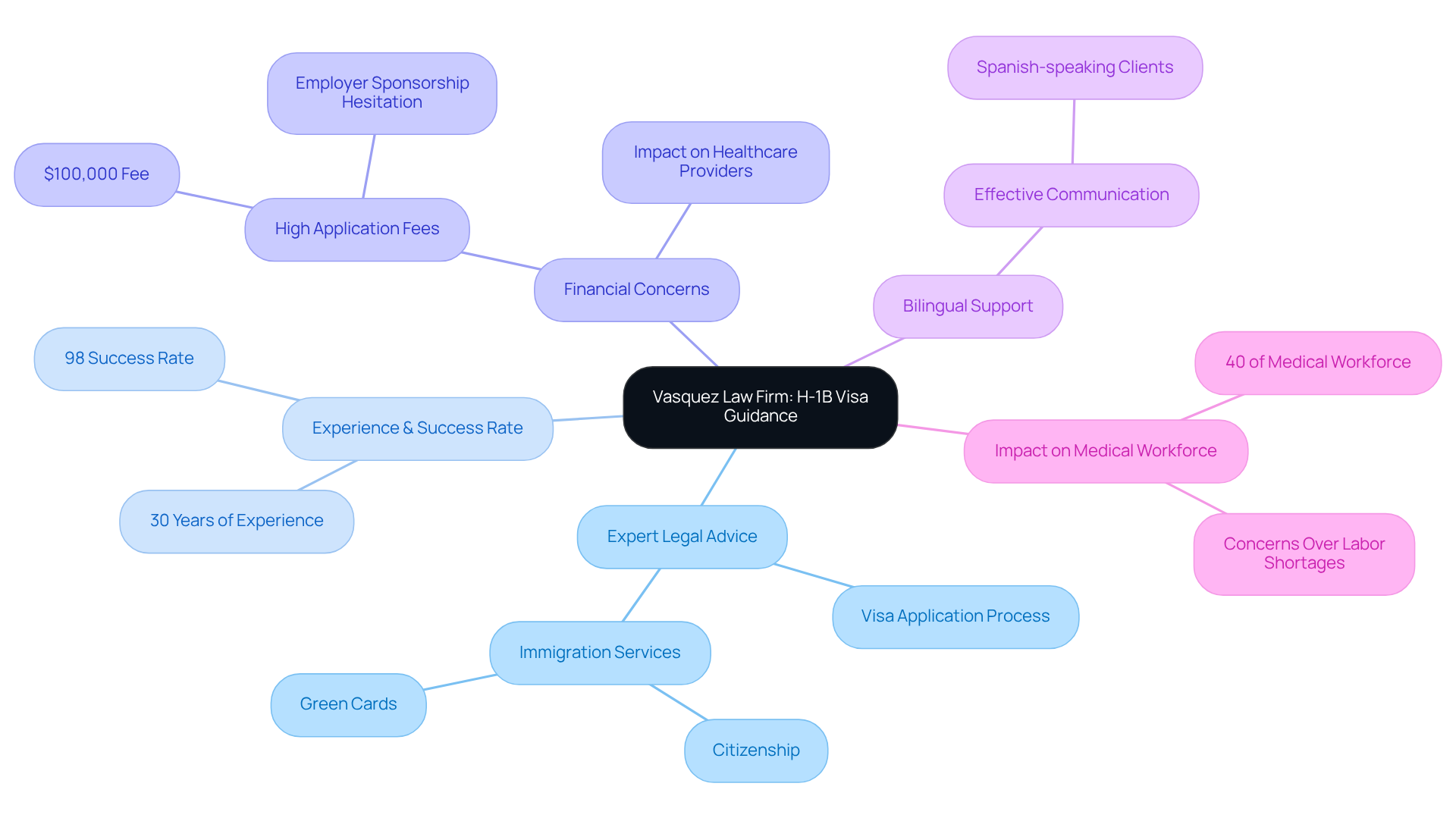
Recent Changes to H-1B Visa Regulations Impacting Healthcare Professionals
The recent to visa regulations, particularly the introduction of a $100,000 application fee starting September 21, 2025, presents substantial challenges for medical professionals and employers. This fee imposes significant financial barriers, especially for rural and community hospitals that already operate on tight budgets. The revised fee arrangement highlighted in the H-1B visa news could lead to an estimated additional expense of $1 million for companies sponsoring numerous H-1B employees each year, prompting many medical facilities to reconsider their hiring strategies.
Moreover, the , which restricts the arrival of specific nonimmigrant workers, compounds the difficulties in recruitment for medical facilities that depend on foreign-trained professionals. Immigration policy analysts caution that these changes may discourage from seeking opportunities in the U.S., worsening the existing physician shortage, particularly in underserved areas. The may drive , who are often less inclined to work in rural settings, potentially leaving critical positions unfilled and impacting patient care.
Additionally, the administrative burdens associated with preparing a National Interest Exception (NIE) packet add another layer of complexity for employers in the medical sector as they navigate these changes. As employers strive to adapt, some may explore alternative visa pathways, such as O-1 and EB-1A visas, to alleviate the impact of the new fee structure. The vital role that IMGs play in addressing the physician shortage underscores the urgency of this situation; decreased recruitment could further hinder access to medical services in underserved communities. Ultimately, the but also threatens the and patient safety, making it crucial for medical employers to strategize effectively in response to these regulatory changes.
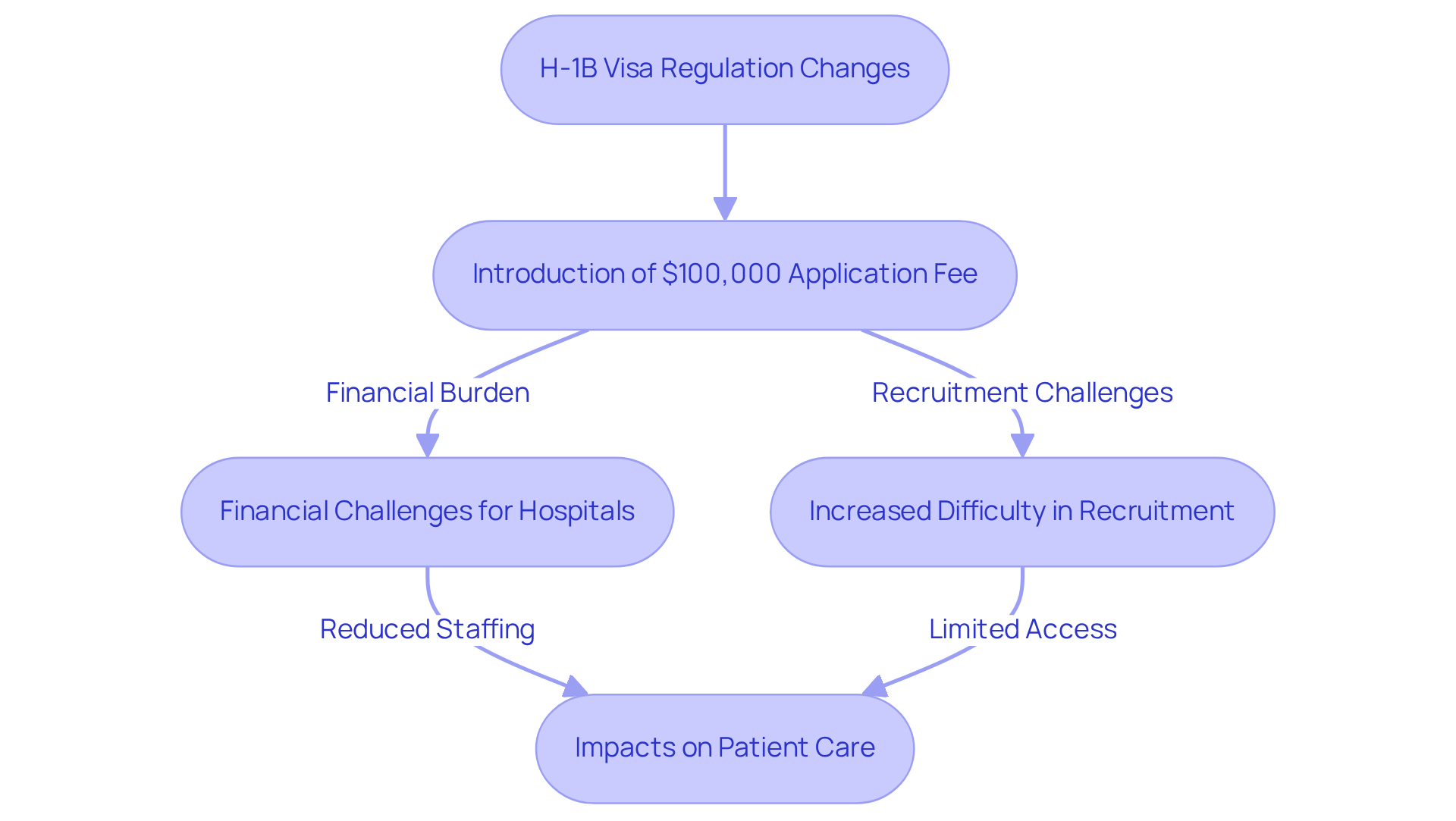
Economic Contributions of H-1B Visa Holders in the Healthcare Sector
Visa holders play a crucial role in the U.S. medical field, effectively tackling significant shortages across various professions. Their specialized abilities and knowledge are especially vital in underserved regions, where they strengthen the workforce and ensure the provision of .
Have you ever wondered how ? Studies indicate that these individuals not only enhance medical services but also invigorate by creating job opportunities and making substantial contributions to tax revenue. In fact, holders of work permits and their families contribute approximately $86 billion annually to the U.S. economy, including about $24 billion in federal payroll taxes and $11 billion in state and local taxes. This underscores their nationwide.
Moreover, with more than 43,000 residency positions occupied annually by foreign workers—who account for over 30% of —their contributions are essential in supporting the , especially in primary care and specialty areas.
We understand how overwhelming these statistics can feel, but it’s important to know that these workers are fighting for for all of us.
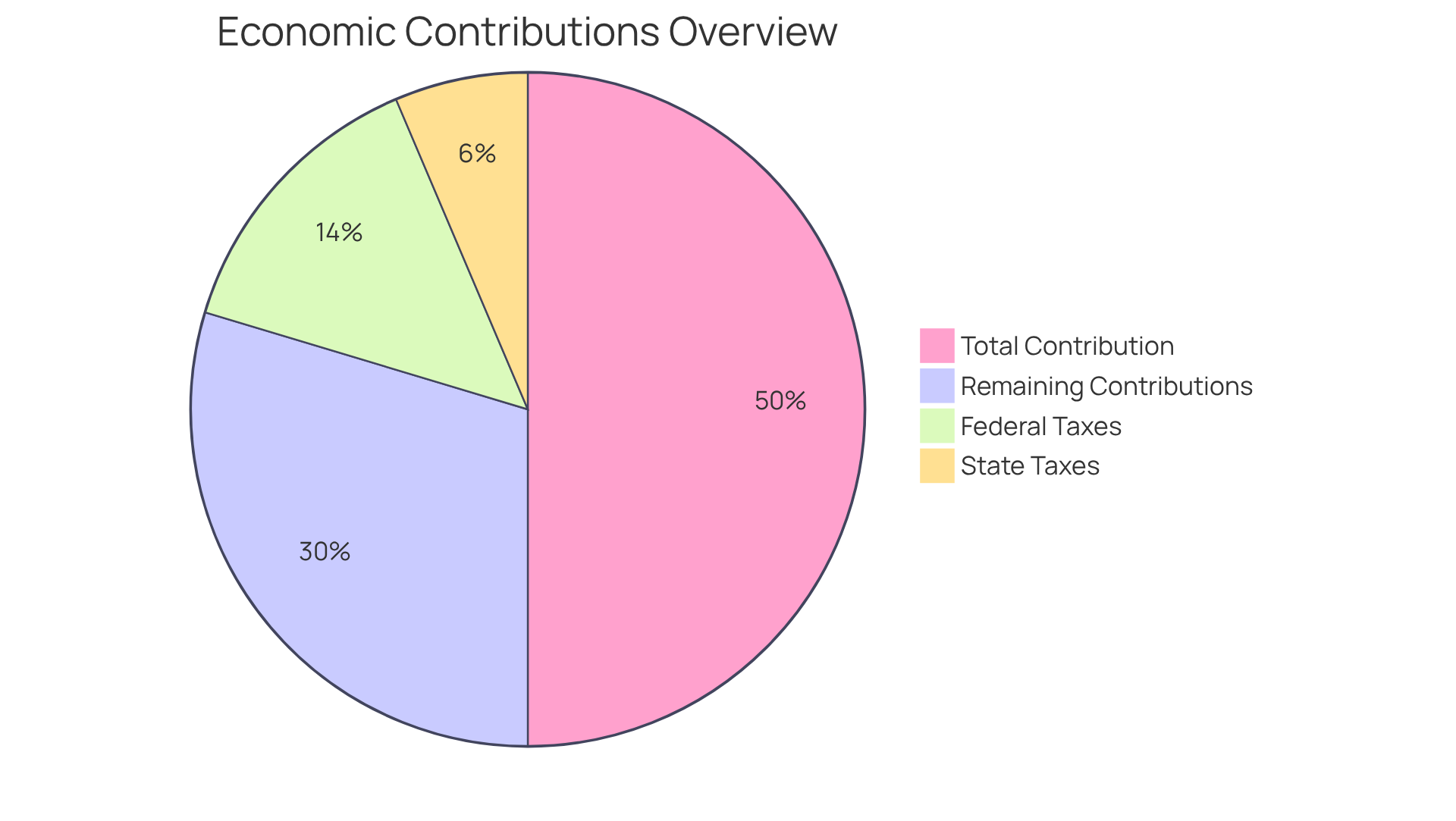
Challenges Immigrant Healthcare Workers Face in the H-1B Visa Process
encounter , characterized by , lengthy processing times, and increasing application fees. With the introduction of a in 2025, medical employers are understandably concerned about their ability to attract and retain foreign talent. This financial strain is especially challenging for hospitals and clinics already facing workforce shortages. Moreover, the standard processing time for can stretch for several months, complicating the hiring process for critical medical roles.
Have you ever felt overwhelmed by the ? Real-world examples highlight the legal challenges faced by applicants. Many individuals lack the necessary legal knowledge to , often leading to delays or denials. Immigration attorneys emphasize that is crucial; even minor errors can have serious repercussions. This combination of challenges underscores the importance of skilled to effectively advocate for immigrant medical professionals. We’re here to ensure you get the support needed to overcome these hurdles and secure your place in the U.S. medical system. Remember, you’re not alone in this fight.
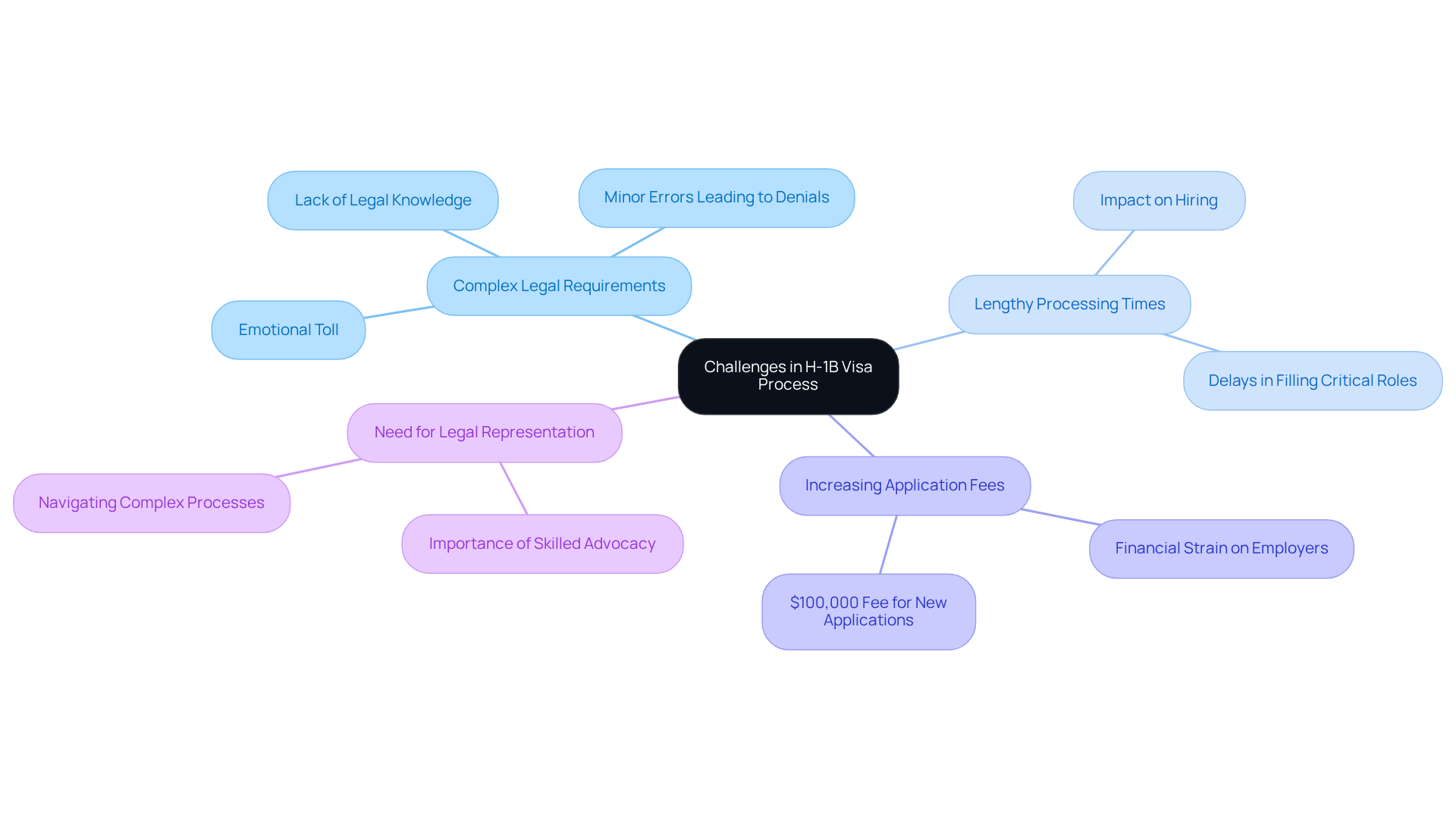
Understanding the H-1B Visa Registration Process for Healthcare Workers
Navigating the can be daunting. First, employers need to secure a job offer for the applicant and file a with the Department of Labor. This application outlines the terms of employment, ensuring that hiring a foreign worker won’t negatively impact the wages and working conditions of U.S. workers. Once the LCA is certified, the employer can submit the visa petition to USCIS.
It’s crucial for to prepare all documentation meticulously, ensuring accuracy and completeness to avoid delays or denials. With the recent introduction of a , [medical employers](https://blog.vasquezlawnc.com/asilo-politico-your-essential-guide-to-the-asylum-process) must also consider how this expense will affect their hiring strategies.
By understanding these steps, along with the associated costs and requirements, medical employers can significantly improve their chances of a . Remember, you’re not alone in this process—we’re here to .
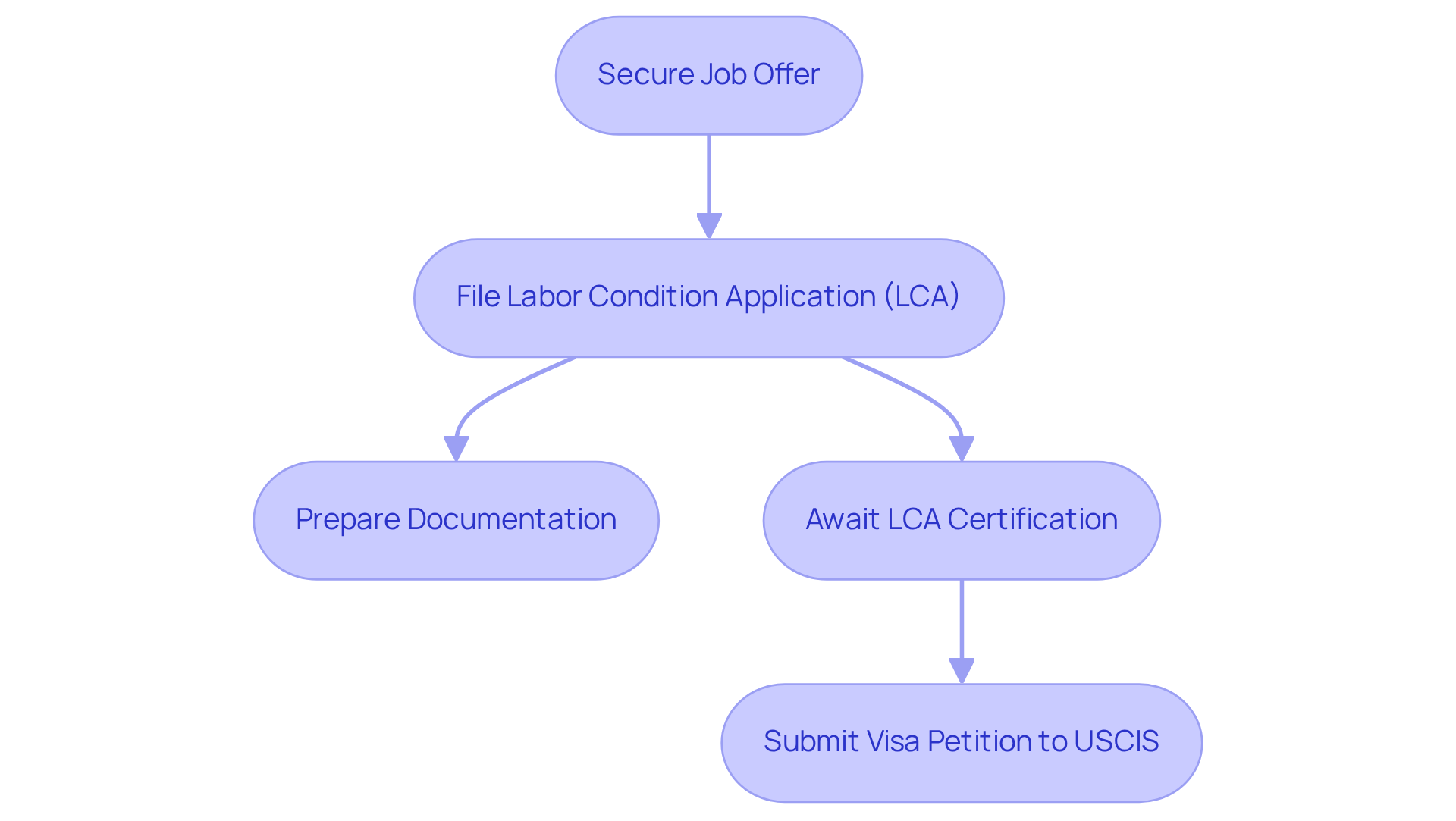
Impact of H-1B Visa Policies on Healthcare Access and Services
The latest shows that regulations directly impact access to in the U.S. According to recent h1b visa news, changes such as increased fees and stricter rules may discourage employers in the medical field from hiring foreign-trained professionals. This could , leading to and reduced , especially in rural and underserved areas. Attracting and retaining is crucial for ensuring high-quality services and making sure all patients receive timely attention.
We understand how overwhelming this situation feels. The ability to access medical care should not be hindered by . It’s vital that we advocate for a system that supports healthcare providers so they can continue to serve our communities effectively. Together, we must of those who dedicate their lives to healing others.
Your future matters to us. We’re here to fight for your family and ensure that everyone has they deserve. Yo Peleo — We Fight.
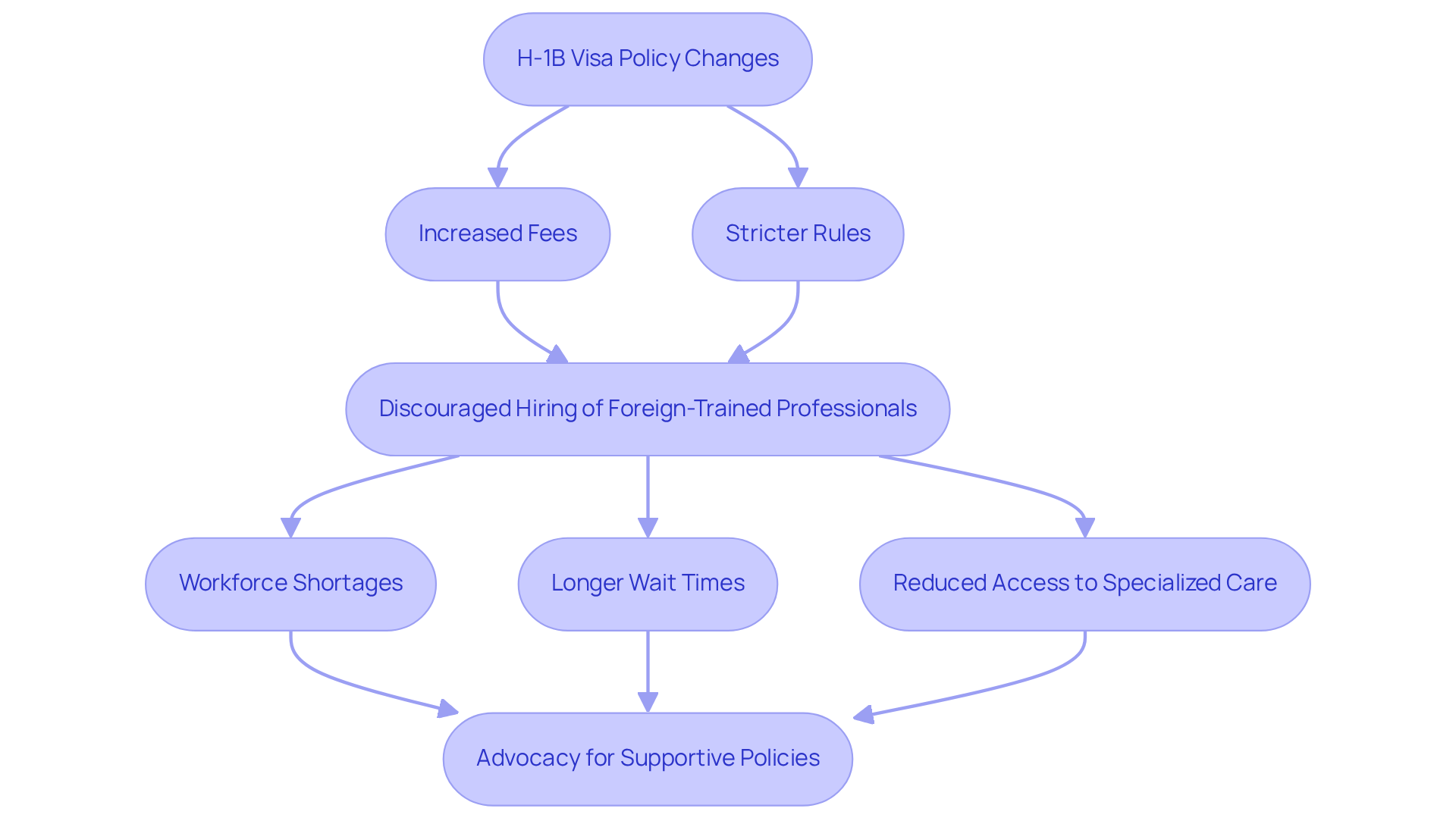
Community Support for Immigrant Healthcare Workers Navigating H-1B Visas
Community assistance is vital for immigrant medical professionals navigating the . Local organizations, advocacy groups, and professional networks provide , mentorship, and emotional support.
- Have you ever felt lost in the immigration process?
- by providing , offering guidance, and sharing experiences that clarify the application process.
- The exemplifies this commitment with its regular "" workshops, educating , including immigration matters.
- Furthermore, the firm collaborates with local organizations, churches, and schools to deliver to underserved communities.
We understand how overwhelming this feels. By fostering a nurturing atmosphere, communities empower immigrant medical professionals to navigate the complexities of the immigration process, enhancing their contributions to the medical system.
With a projected in the U.S. within the next decade, the support from like those from Vasquez Law Firm is more critical than ever. Your future matters to us.
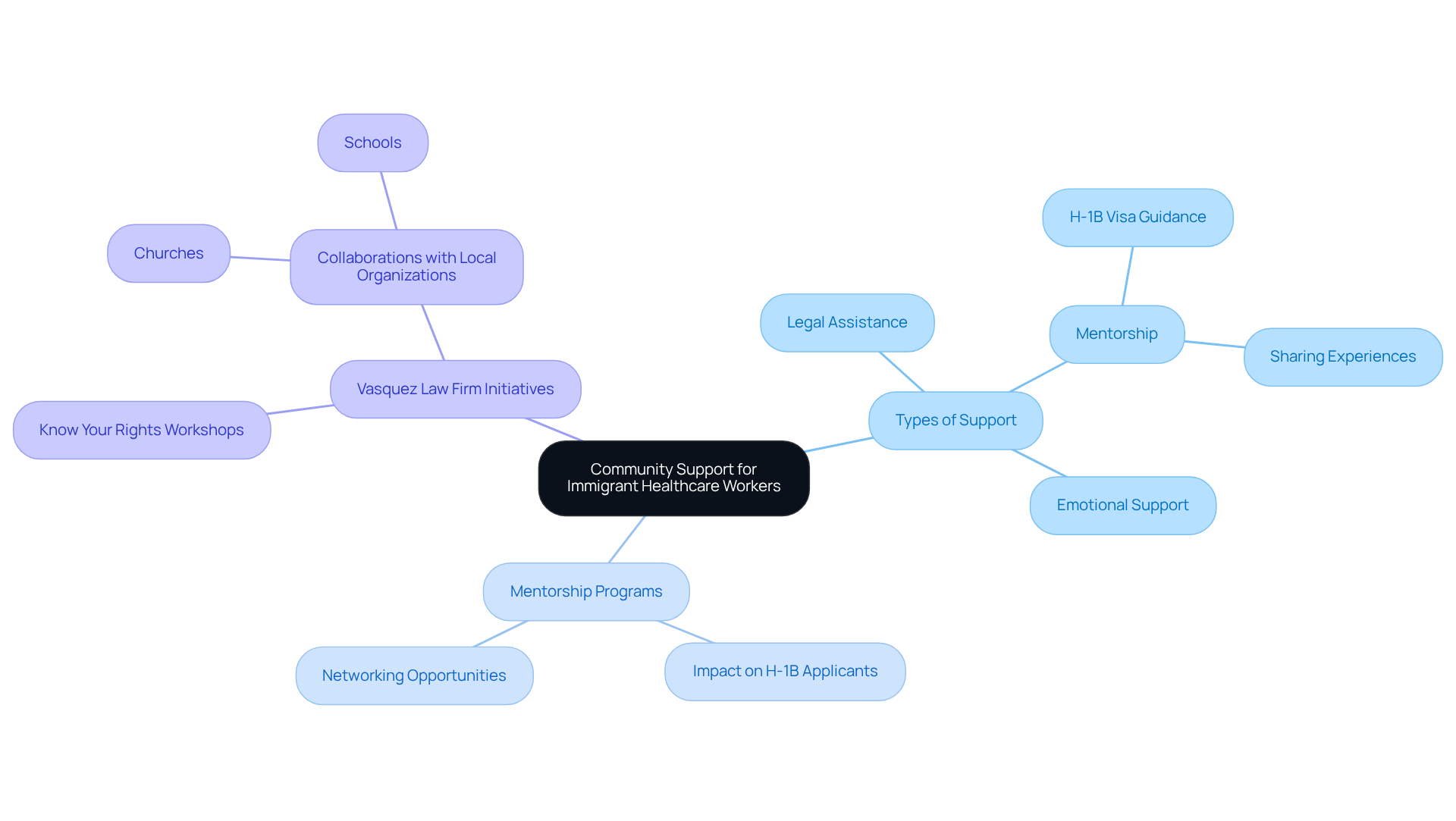
The Importance of Legal Representation in H-1B Visa Applications
is essential for immigrant medical professionals navigating the complexities of . An experienced , like those at Vasquez Law Firm, is crucial in guiding applicants through this intricate legal landscape. They ensure that all documentation is meticulously prepared and compliant with current regulations.
Have you ever felt lost in the immigration process? Studies show that applications with legal assistance boast significantly higher . Attorneys provide critical insights into the nuances of immigration law, helping clients understand their rights and available options.
With recent changes in work permit regulations, including a and an annual limit of 65,000 permits, the expertise of is more vital than ever. They can help , respond effectively to Requests for Evidence (RFEs), and enhance the likelihood of a successful application.
As immigration attorney Di Martino noted, 'The process can be labyrinthine, with regulations and deadlines that seem never-ending.' Thus, obtaining legal support not only streamlines the application procedure but also greatly enhances the likelihood of acquiring a permit, making it a smart investment for medical professionals aiming to work in the U.S.
Furthermore, , ensuring that injured individuals receive the restitution and medical attention they deserve. Beneficiaries of the work visa are allowed a maximum stay of three years, with the potential for extension, highlighting the significance of .
We understand how overwhelming this feels; you don’t have to face it alone—we’ll guide you every step of the way.
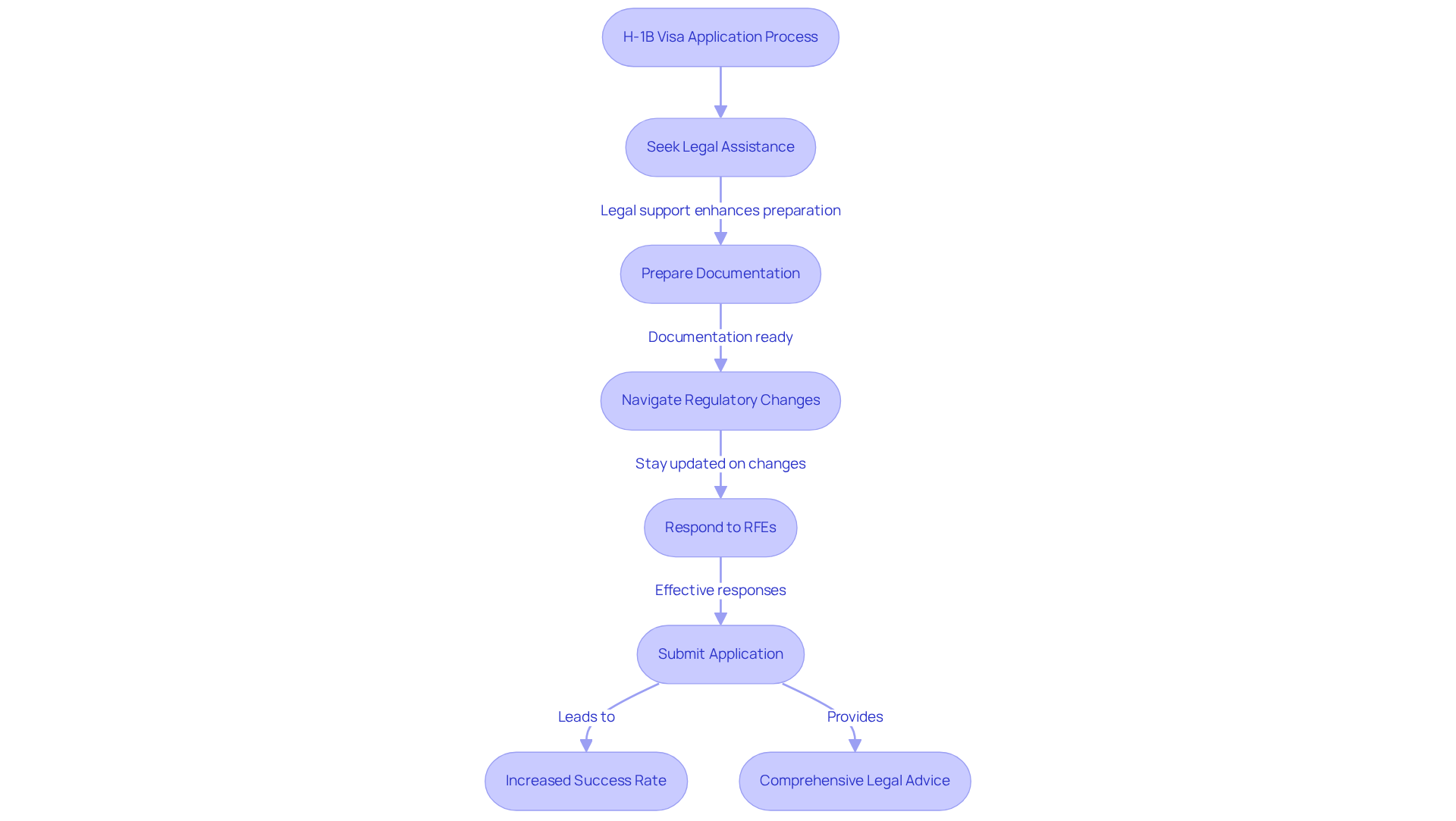
Future Outlook for H-1B Visa Policies Affecting Healthcare Workers
The outlook for impacting medical workers is uncertain. Congress is actively discussing immigration reform, which could lead to significant changes in existing regulations. on securing exclusions for medical professionals from the proposed $100,000 fee, emphasizing their vital contributions to the U.S. medical system.
Notably, 23.1% of support personnel in the U.S. are immigrants, underscoring the . As the demand for medical services continues to rise, it becomes increasingly important for policymakers to address the challenges faced by . This includes:
- Streamlining processes
- capable of meeting the nation’s healthcare demands.
Medical workers are encouraged to stay informed and engaged by joining advocacy efforts and .
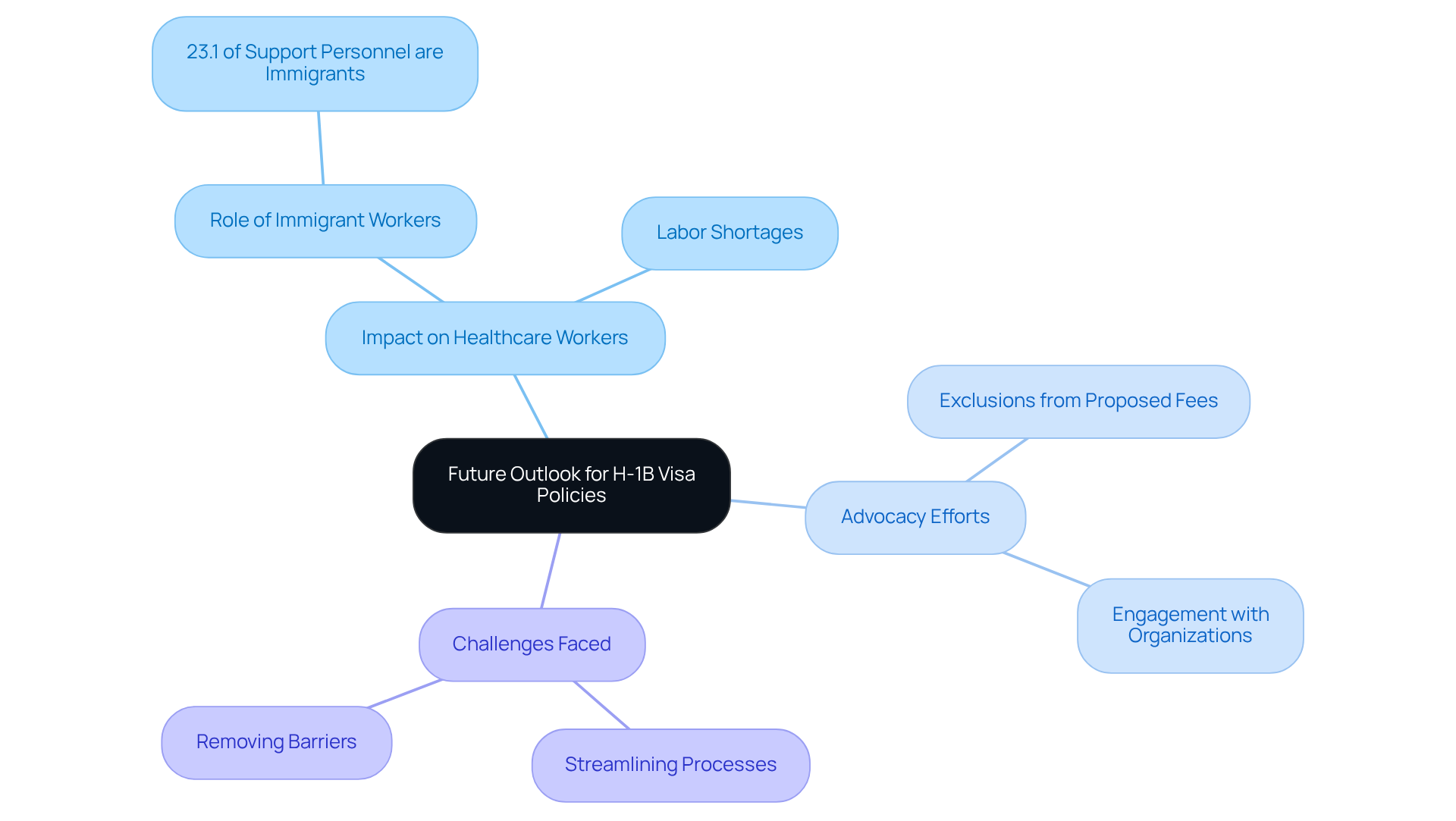
Essential Resources for Staying Updated on H-1B Visa News for Healthcare Workers
Healthcare experts, are you feeling overwhelmed by the ever-changing landscape of news developments? You’re not alone. can make a significant difference. Websites like USCIS, the , and the American Medical Association (AMA) provide and regulations. The AMA advocates for DACA recipients, highlighting that "individuals who lack insurance experience poorer health and have shorter lifespans." This underscores the vital need for . Furthermore, did you know that the median yearly income for sanctioned visa applicants was $118,000 in FY 2022? This statistic illustrates the promising economic prospects available to .
Joining can greatly enhance your chances of success, according to the latest H-1B visa news. These organizations champion policies that support immigrant medical staff and foster a network where peers share invaluable insights and experiences. Additionally, engaging in online forums and communities can help you connect with fellow professionals facing similar challenges, providing both support and practical guidance. By leveraging these resources, you can better position yourself to . Remember, you don’t have to face this journey alone—we’re here to fight for your future.
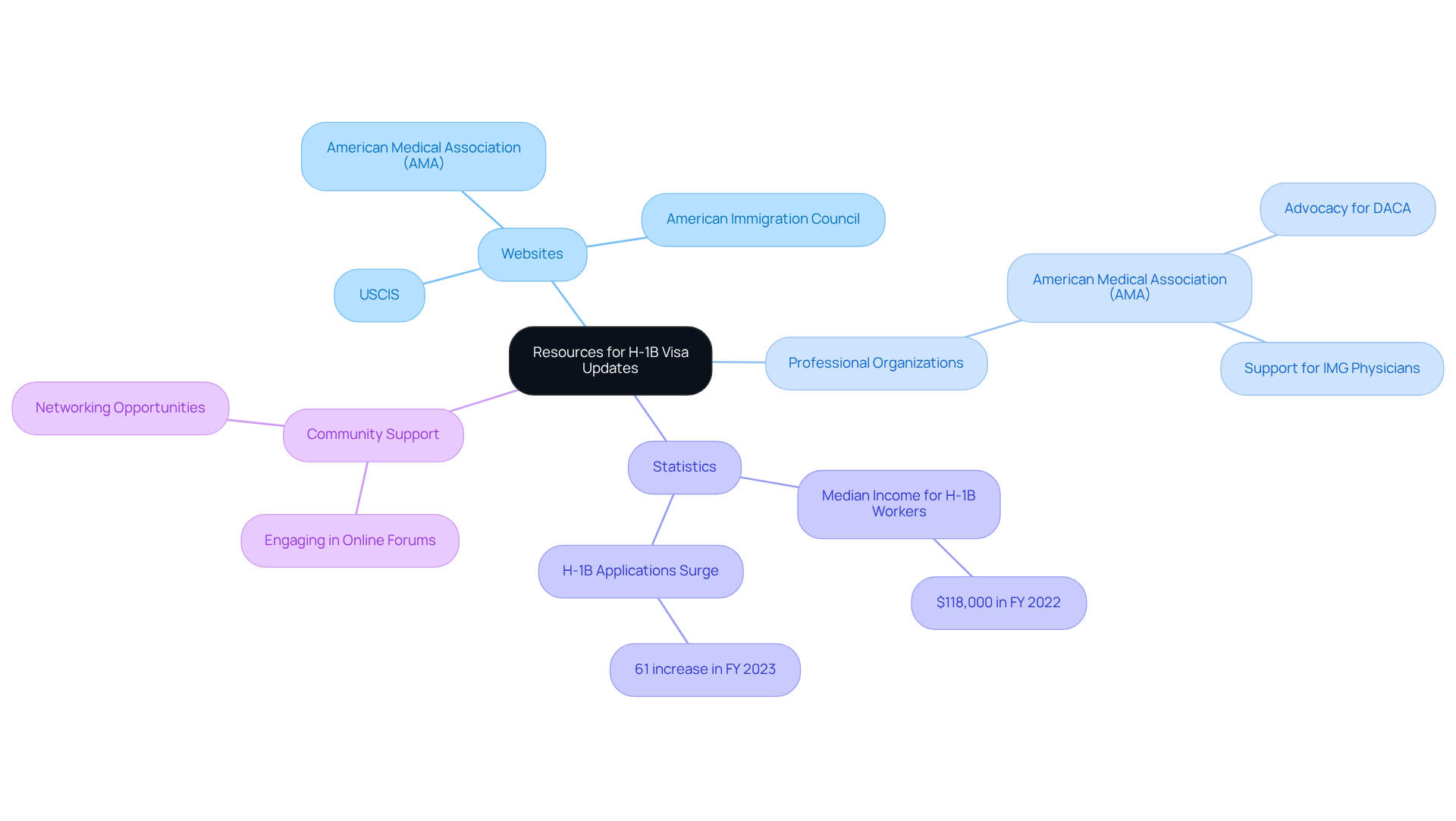
Conclusion
The landscape of H-1B visa regulations for immigrant healthcare workers is changing significantly, bringing both challenges and opportunities. As this article highlights, the introduction of hefty application fees and stricter regulations may discourage employers from hiring foreign-trained medical professionals, potentially worsening the existing workforce shortages in healthcare. Understanding these dynamics is crucial for everyone involved in the recruitment and support of immigrant healthcare workers.
Key insights reveal that the new $100,000 application fee creates a substantial barrier, particularly for rural and community hospitals. Immigrant healthcare workers play a vital role, representing a significant part of the medical workforce, especially in underserved areas. Community support, legal representation, and access to resources are essential for navigating the complexities of the H-1B visa application process. Organizations like Vasquez Law Firm are pivotal in providing guidance and advocacy for these professionals.
Looking ahead, it’s imperative for medical employers and immigrant healthcare workers to stay informed and engaged with ongoing advocacy efforts aimed at reforming H-1B visa policies. The future of healthcare access and quality in the U.S. relies on a diverse and skilled workforce. Addressing the challenges highlighted in this article is essential to achieving that goal. By fostering collaboration and support within the community, we can work towards a more equitable immigration system that benefits both healthcare professionals and the patients they serve. We’re here to fight for your family. Your future matters to us. Yo Peleo — We Fight.
Frequently Asked Questions
What services does Vasquez Law Firm provide for healthcare workers regarding H-1B visa applications?
Vasquez Law Firm offers expert legal advice for medical professionals navigating the H-1B visa application process, as well as essential immigration services such as green cards and citizenship.
What is the success rate of Vasquez Law Firm in handling visa applications?
The firm has an impressive 98% success rate in assisting clients with their visa applications.
What financial challenges do medical professionals face when applying for H-1B visas?
Many employers hesitate to sponsor individuals for work visas due to the financial burden, as the application process can cost around $100,000 per applicant.
How does Vasquez Law Firm support Spanish-speaking clients?
The firm has a bilingual team that ensures effective communication, making the application process smoother for Spanish-speaking clients.
Why are foreign nationals significant in the medical workforce?
Foreign nationals constitute over 40% of the medical workforce, highlighting the importance of understanding their rights and options amid changing immigration policies.
What recent changes to H-1B visa regulations were announced?
A new $100,000 application fee for H-1B visas will be implemented starting September 21, 2025, which presents substantial financial challenges for medical professionals and employers.
How might the new H-1B visa fee affect rural and community hospitals?
The $100,000 fee could impose significant financial barriers, potentially leading to an estimated additional expense of $1 million for companies sponsoring multiple H-1B employees, prompting hospitals to reconsider their hiring strategies.
What impact do the new regulations have on International Medical Graduates (IMGs)?
The changes may discourage IMGs from seeking opportunities in the U.S., worsening the existing physician shortage, particularly in underserved areas.
What are the economic contributions of H-1B visa holders in the healthcare sector?
H-1B visa holders contribute approximately $86 billion annually to the U.S. economy, including about $24 billion in federal payroll taxes and $11 billion in state and local taxes, while also enhancing medical services and creating job opportunities.
How many residency positions are occupied by foreign workers in the U.S.?
Foreign workers occupy more than 43,000 residency positions annually, accounting for over 30% of U.S. residency roles.


